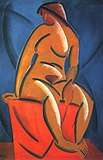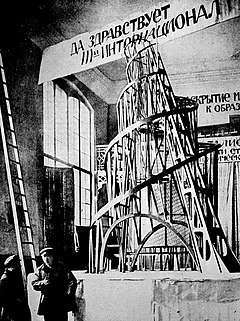Vladimir Tatlin
Vladimir Tatlin (28 December [O.S. 16 December] 1885 – 31 May 1953)[1] was a Russian-Ukrainian and Soviet painter, architect and stage-designer. Tatlin achieved fame as the architect who designed The Monument to the Third International, more commonly known as Tatlin's Tower, which he began in 1919.[2] With Kazimir Malevich he was one of the two most important figures in the Soviet avant-garde art movement of the 1920s, and he later became an important artist in the Constructivist movement.

Biography
Vladimir Tatlin (full name Vladimir Yevgrafovich Tatlin) was born in Moscow,[1] Russian Empire. His father, Yevhraf Nikoforyvych Tatlin was a hereditary nobleman from Oryol, a mechanical engineer graduated from the Technological Institute in St.Petersburg and employed by the Moscow-Brest Railway in Moscow.[3][4] His mother, Nadezhda Nikolaevna Tatlina (Bart), was a poet symphatizing the Narodnaya Volya revolutionary movement.[5] After she died in 1887, his father married again and resettled to Kharkiv.[6] His father, by whom he lived after having failed to study in Moscow School of Painting, Sculpture and Architecture died in 1904, so young Vladimir had to interrupt his studies at the Kharkov Arts School and to leave for Odessa to become a merchant sea cadet. According to his own memories, sea and distant lands gave him both means of subsistence and source of inspiration; he sailed all across the Black Sea and also to Egypt.[6]
In 1905 he started and in 1910 successfully completed his studies at N.Selivestrov Penza Art School in Penza. During the summer vacations he traveled to Moscow and St.Petersburg to participate in various art events. In 1911 he resettled to Moscow to live by his uncle and began his art career as an icon painter. He also sang in Ukrainian and was a professional musician-bandurist, and performed as such abroad.[7]
Tatlin became familiar with the work of Pablo Picasso during a trip to Paris in 1913.[8]
Tatlin achieved fame as the architect who designed the huge Monument to the Third International, also known as Tatlin's Tower. Planned from 1919,[2] the monument was to be a tall tower in iron, glass and steel which would have dwarfed the Eiffel Tower in Paris (the Monument to the Third International was a third taller at 400 meters high). Inside the iron-and-steel structure of twin spirals, the design envisaged three building blocks, covered with glass windows, which would rotate at different speeds (the first one, a cube, once a year; the second one, a pyramid, once a month; the third one, a cylinder, once a day). For financial and practical reasons, however, the tower was never built.[9][10]
Tatlin was also regarded as a progenitor of Soviet post-Revolutionary Constructivist art with his pre-Revolutionary counter-reliefs, three-dimensional constructions made of wood and metal,[11] some placed in corners (corner counter-reliefs) and others more conventionally.[12] Tatlin conceived these sculptures in order to question the traditional ideas of art, though he did not regard himself as a Constructivist and objected to many of the movement's ideas. Later prominent constructivists included Varvara Stepanova, Alexander Rodchenko, Manuel Rendón Seminario, Joaquín Torres García, László Moholy-Nagy, Antoine Pevsner and Naum Gabo.
Although colleagues at the beginning of their careers, Tatlin and Malevich quarrelled fiercely and publicly at the time of the 0.10 Exhibition in 1915 (long before the birth of Constructivism), also called "the last futurist exhibition", apparently over the 'suprematist' works Malevich exhibited there. This led Malevich to develop his ideas further in the city of Vitebsk, where he found a school called UNOVIS (Champions of the new art).
Tatlin also dedicated himself to the study of clothes, and various objects, and flight, culminating in the construction of Letatlin personal flying apparatus.[13]
In the year of 1930 he taught in Kiev where one of his students was Joseph Karakis.[14]
From the 1930's Tatlin worked for different theatres in Moscow and during the Great Patriotic War, in Gorkiy. In 1948 he was heavily criticized for his allegedly anti-communist stance and lost his job, but was not repressed.[15]
Tatlin died in 1953 in Moscow and was buried at the Novodevichy Cemetery.[16]
Gallery of works
 Tatlin, 1913, Female Model / Натурщица, oil on canvas
Tatlin, 1913, Female Model / Натурщица, oil on canvas_05.jpg) Tatlin 1913, scene design for the play 'A Life for the Tsar'
Tatlin 1913, scene design for the play 'A Life for the Tsar'- Tatlin, 1916, Counter-relief, sculpture of several materials
 Tatlin, 1919–20, Tatlin's tower, official title: Monument to the Third International, the design was never built
Tatlin, 1919–20, Tatlin's tower, official title: Monument to the Third International, the design was never built Tatlin, 1919–20, recently made copy of Tatlin's tower, Monument to the Third International, a later model
Tatlin, 1919–20, recently made copy of Tatlin's tower, Monument to the Third International, a later model Tatlin, 1920s, dress-design
Tatlin, 1920s, dress-design- Tatlin, 1923–24, Costumes
.jpg) Tatlin, 1929-1931: Letatlin № 1., sculpture; human-powered ornithopter
Tatlin, 1929-1931: Letatlin № 1., sculpture; human-powered ornithopter- Tatlin, 1930–1932, Letatlin № 3., sculpture; human-powered ornithopter
 Tatlin, c. 1942, Window Cleaner and Portrait of V., brush on paper
Tatlin, c. 1942, Window Cleaner and Portrait of V., brush on paper
Notes
- Lynton, Norbert (2009). Tatlin's Tower: Monument to Revolution. New Haven: Yale University Press. p. 1. ISBN 978-0300111309.
- Honour, H. and Fleming, J. (2009) A World History of Art. 7th edn. London: Laurence King Publishing, p. 819. ISBN 9781856695848
- Tatlin. Zhadova, L. (Larisa). New York: Rizzoli. 1988. p. 321. ISBN 0847808270. OCLC 15054267.CS1 maint: others (link)
- "Татлин, Евграф Никифорович - Отчет о поездке для изучения системы сменных бригад на паровозах американских железных дорог / - Search RSL". search.rsl.ru. Retrieved 2018-12-05.
- "ТАТЛИН Владимир Евграфович". Encyclopedia of Russian Avantgarde (in Russian). Retrieved 2018-12-05.
- Terekhovich, Marina. "ТАЙНОВИДЕЦ ИЗ ОТРЯДА СОЛНЦЕЛОВОВ. К 125-летию со дня рождения В.Е. Татлина". www.archjournal.ru. Journal for Architecture. Retrieved 2018-12-05.
- http://en.uartlib.org/exclusive/tatlin-graye-na-banduri/
- Gray, Camilla, (1986) The Russian Experiment in Art 1863-1922. rev. by Marian Burleigh-Motley. London: Thames & Hudson. p. 174.
- Janson, H.W. (1995) History of Art. 5th edn. Revised and expanded by Anthony F. Janson. London: Thames & Hudson, p. 820. ISBN 0500237018
- Singh, Iona (2012) Aesthetic World in the Future - chapter from Color, Facture, Art & Design. Hampshire: Zero Books, p. 104-128. ISBN 978-1-78099-629-5
- Tatlin, Vladimir Evgrafovich: Counter-relief (Material Assortment). The State Tretyakov Gallery, 2013. Retrieved 10 May 2013. Archived 2013-07-28 at the Wayback Machine
- Boersma, Linda S. (1994) The Last Futurist Exhibition of Painting: 0,10. Rotterdam: 010 Publishers, p. 63. ISBN 9064501351
- Maria Antonova (2017-01-10). "The Bird-Like Soviet Flying Machine That Never Quite Took Off". Atlas Obscura. Retrieved 2019-10-19.
- Юнаков 2016, p. 53.
- ""Отец" художественного авангарда". tatlin.ru. Retrieved 2018-12-05.
- "Таким помню Татлина. Мемуары Анны Бегичевой". НЛО (in Russian). Retrieved 2018-12-05.
References
- Юнаков, О. (2016). Архитектор Иосиф Каракис. Алмаз. ISBN 978-1-68082-000-3.CS1 maint: ref=harv (link)
External links
| Wikiquote has quotations related to: Vladimir Tatlin |

- Tatlin Playing The Bandura. Special Project of the Library of Ukrainian Art.
- Exhibition of Russian-Soviet artist Vladimir Tatlin in Basel — Tatlin’s “new art for a new world”
- Photographs of Tatlin and his assistants constructing the first model for the monument to the Third International, Petrograd, 1920, Canadian Centre for Architecture (digitized items)